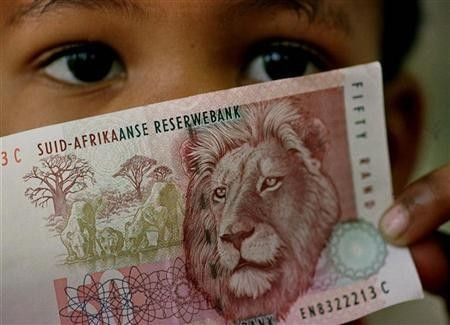SAfrican rand weak on debt worries, seen vulnerable

South Africa's rand fell 1.7 percent against the dollar on Monday and was seen vulnerable to further weakness that could take it to this year's low at 8.4950.
Investors dumped high risk assets as debt worries in both the euro zone and the United States took centre stage with U.S. leaders seen unlikely to reach a deficit-cutting deal to tackle the country's mounting debt.
The rand fell to 8.3488, its weakest since October 4.
Government bonds mirrored its weakness, with yields rising across the curve.
By 1532 GMT, the rand stood at 8.3230 against the dollar, 1.5 percent weaker than Friday's New York close of 8.20.
The rand is more vulnerable to risk aversion when the euro is under pressure, said Anisha Arora, emerging market analyst at 4CAST, as the euro was near five-week lows to the dollar.
This suggests that now that dollar/rand is at 6 week highs, a fresh negative waves from the global backdrop could bring the September highs into focus.
The rand hit 8.4950 in September, its weakest in 28 months.
It will have to pierce the October 4 high of 8.3528 to open up for 8.4950, said IFR, a Thomson Reuters market research and analysis service.
The rand has fallen by 26 percent against the dollar so far this year, mainly a victim of ongoing worries about fiscal woes in the euro zone, a major trading partner of South Africa.
As a heavily traded global currency, it is a proxy for risk sentiment and has been driven more by global events than local developments this year.
The Reserve Bank has said the rand's weakness was an upside risk to the inflation outlook but it could not control its volatility.
October's consumer inflation data will be released on Wednesday and is expected to show annual CPI rose to 5.9 percent, just a touch off the upper end of the Reserve Bank's 3-6 percent target band.
Government bonds have fallen in recent weeks on diminishing expectations for another rate cut -- partly on rising inflation -- and the rand has compounded the weaker trend.
The yield on the 2015 bond was up four basis points to 6.83 percent and that on the 2026 issue climbed 7.5 basis points to 8.525 percent.
© Copyright Thomson Reuters 2024. All rights reserved.





















